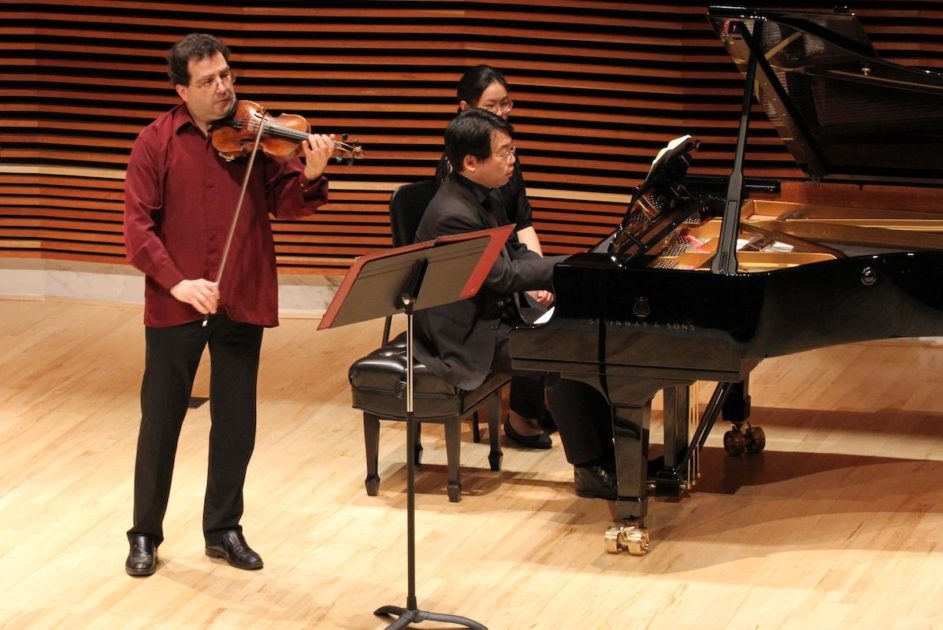There were moments during Beethoven’s “Sonata No. 5 in F Major for Violin and Piano,” Op. 24, when Chih-Long Hu’s piano was off on extended rampages by itself that violinist Miroslav Hristov played single, longer notes at rather patient intervals just to remind the piano that the violin was still there.
Known as the “Spring” sonata because of its generally sunny disposition, the F Major also explores the left-hand, lower-pitch end of the piano in ways the first four sonatas don’t. The result creates often-thick sonorities, kind of like dark clouds on an otherwise bright, cheerful day.
In this, the second concert in Hristov and Hu’s exploration of all 10 of Ludwig van Beethoven’s sonatas for violin and piano, played in the order of their composition, one began to hear the role of the violin change from accompaniment for the piano to more equal partner in the sixth and seventh sonatas, which followed the fifth on the program.
The audience at Monday night’s concert in the Sandra G. Powell Recital Hall at the University of Tennessee’s Natalie Haslam Music Center was a bit larger than that of the first concert, when Hristov and Hu presented the three opus 12 sonatas and No. 4 of opus 23. Understandable, since Hristov and Hu are beginning to get into material in which the piano is no longer the dominant instrument, although the original publication of the group of three sonatas of opus 30 – numbers 6, 7 and 8, still bore the title “Three sonatas for the pianoforte with the accompaniment of a violin.”
At the time of writing the opus 30 sonatas, Beethoven was realizing he was losing his hearing. It’s thought that his determination to conquer this problem led him to dedicate this set of three to the determined, but often heavy-handed Emperor Alexander I of Russia, as well as his “Third Symphony” to Napoleon, whom Beethoven initially saw as a great liberator of people, but which he later un-dedicated because of Napoleon’s megalomania.
In a famous letter to his brother, Beethoven addressed his hearing struggles by saying, “I will seize fate by the throat – it will certainly not crush me completely.” It certainly didn’t because his greatest music was to come after his hearing loss began.
In “Sonata No. 6 in A Major for Violin and Piano,” Op. 30, No. 1, Hu played bolder, often fiery runs in the left-hand, lower notes of the piano. But there were also lovely melodies shared by the violin and piano, switching back and forth with lightning-quick passages. There were also moments of extended, legato phrases offset with syncopations.
The “Adagio molto expressivo” (“slow and very expressive”), second movement, had a gorgeous melody in the violin that had the quality of an operatic aria, passed off to the piano.
Then, in the third movement, both the violin and piano got chances to show off.
The “Sonata No. 7 for Violin and Piano,” Op. 30, No. 2, is written in the key of C Minor. Described as the “key of death,” it’s also the key of the “Fifth Symphony,” with its powerful “Fate knocking on the door” in its opening phrases and the sadness of the “Pathétique Piano Sonata.”
It had lovely spring-like moments as heard in the fifth sonata. But there were also moments of silence interrupted by sharp, slashing sounds that cut through the silence.
The third concert, on Monday, Feb. 25, will complete Hristov and Hu’s adventure through the violin and piano sonatas with numbers 8, 9 and 10. Its centerpiece will be the “Sonata No. 9 in A Major for Violin and Piano,” Op. 47, known as the “Kreutzer Sonata” after its dedication to the French violinist Rodolphe Kreutzer.
Tolstoy thought this sonata possessed such power for sexual arousal he titled his novella about a love affair after it.
More information about this concert and other, often free, concerts at the UT School of Music can be found here.

